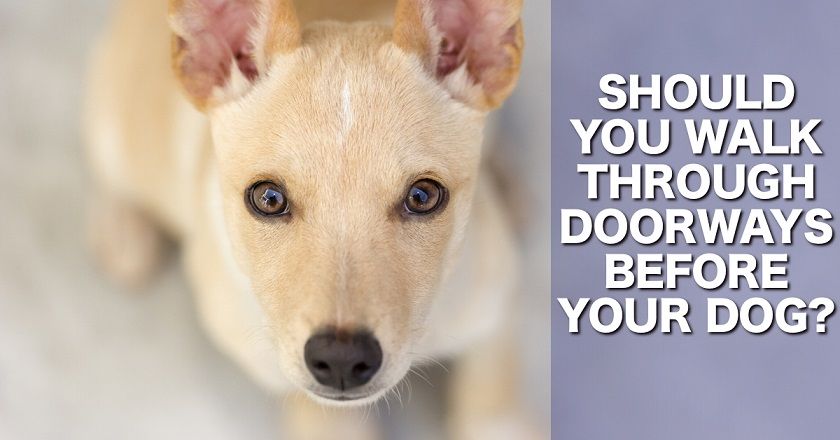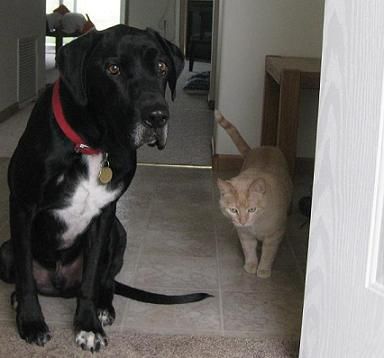I expect dogs to be calm at the door and going through the doorway.
Of course, we all know by now never to say “always” when talking about dog training.
I don’t really expect you to walk through doors before your dog EVERY SINGLE TIME. Yikes.
However, teaching your dog to be CALM at the door is obviously very beneficial. That’s what this post is really about. Teaching your dog self-control.
Why I teach my dog to be calm in doorways
You don’t have to believe that whoever goes through the door first is – God forbid – dominant. I wouldn’t think about it like that.
(Although, if your dog is especially impressed with himself, it would do him some good to be second more often.)

Instead, think of it as teaching your dog self-control, because a dog who has self-control is going to be a happier dog in general who gets to go more places because he’s easier to manage. He’s less likely to pull, jump on people, etc.
And, simply, barging through doors is rude!
So when I’m training a new dog, I expect him to learn to be calm at the door and while going through doorways.
All dogs can learn polite door manners. I don’t care if he’s a big, strong, pushy dog. He can learn to pause, sit and wait.
The dangers of door-barging
A dog who barges through the door is obviously dangerous because:
- He could pull someone down
- He could knock someone over
- He could cause you to drop what you’re carrying or get your arm caught in the door
- He could bolt after something and get hit by a car
- If he’s not paying attention to you before your walk even starts, good luck with the rest of that walk! 🙂
So yes, I do walk through doors first when it’s reasonable, and I expect a pause before and after we head through the door.
Of course, it’s not always reasonable to walk through the door before your dog. It’s often much easier to let the dog go first and that is absolutely fine! Just make sure you’re really the one who’s making that decision.
For example, my apartment has a heavy front door that opens inward. It’s just easier to have Ace go through the door first while I hold it open, especially if I’m carrying out the trash.
My dog is trained to pause before and after we head through the door. He doesn’t need a leash. He just stands there waiting. Good boy, Ace!
(Note that my dog is far from perfect. He is quite the Door-Barger in other scenarios like if we’re at someone else’s home. Ahh … that’s why training in different contexts is so important. It never ends.)
OK, so by now you see what I mean.
It’s not really about being first. It’s about expecting the dog to be CALM.
So how do we train this behavior?
Well, patience is key. And lots of repetitions over several weeks. And highly valued treats. And working with one dog at a time if you have a houseful.

It’s not about being perfect on the first day but setting small, specific goals and building from there.
For example, simply asking your dog to sit calmly at the door while you have your hand on the door handle might be your first goal and it might take a few days to accomplish.
Your second goal might be to train him to remain in a sit even while you move the handle a bit (quite the challenge for some!).
While you’re working on building your dog’s goals slowly, you can always manage your dog temporarily with any sort of training collar for control while you head through the door. Try to find something that prevents him from pulling hard so likely a Gentle Leader, prong collar or perhaps a no-pull harness.
Once you’re through the door, I recommend you ask him to sit again. This is a good habit to get into, because it encourages him to check in with you.
Quick tips to reinforce calm behavior in doorways:
- Stay calm yourself. Take your time. If you are rushed to get out the door, it only affects your dog.
- Pause and wait for that sit before you put on the collar & before you put on that leash.
- Use highly valued treats.
- Add all kinds of “micro-steps” & work on them one at a time. Can your dog sit while you put your hand on the door knob? How about while you turn the handle? Or when you slightly open the door?
- Pause again once outside. Re-group. Adjust the leash and collar as needed. Situate your keys or bag or whatever you’re carrying.
- Take 15 minutes and create an entire training session around the doorway. Go in and out multiple times. Make it a fun game with treats.
- Quit if you sense frustration from yourself or your dog.
So those are my tips. I know it’s just a start.
What tips would the rest of you add to the list?
Let me know in the comments!
Related posts:

Julia
Monday 13th of December 2021
Would it be reasonable to expect the dog /pup to wait as you enter doorways to bedroom's too? I am finding my 11 week old still barging past me there. But I'm thinking of training him to wait and just walk behind me a bit. 1 its more respectful, and 2, I don't get knocked over by him or does anyone else in the house.
Lindsay Stordahl
Tuesday 14th of December 2021
Yes, it just takes some time, patience and consistency.
Carol (Mattie's Mom)
Tuesday 22nd of December 2020
Our 'going out' routine starts with me sitting on a hassock (in the hallway next to the basket with her leash) waiting for Mattie to calm down and sit (no words are spoken) in front of me. Once she is seated, I put on her leash and we walk to the door. Again, she sits while I open the door. Occasionally, she will attempt to go first, but letting the screen door close gets her attention. Walking out our front door, there is a stoop and then stairs. We pause at the top of the stairs and then proceed. When we return, Mattie sits at the front door while I open the door, but I do let her go in first at this point as others have said.
Clint Howitz
Thursday 25th of May 2017
Nice job on this article, Lindsay. I always practice this myself whenever possible and agree that it's not all about being alpha/reinforcing dominance.
Lindsay Stordahl
Thursday 25th of May 2017
Thanks! Yes, I hear ya!
Keith Amdur
Wednesday 8th of February 2017
When I first got Emma Lou I did the I go befor you thing but there were times she need to go first plus I don`t think the dog cares who go first as long as she gets to come along.After reading and learning (ThatMutt.com and others)I just want her not to jump or bark at people who come by.I worked with her on those things.Shes three now and the best dog ever when people come by.Theres dogs that I walk and the owners ask me what they can do to stop there dogs from going nuts at a knock at the door.I don`t need to go into all I told them but the first thing I said to them was quit picking the dog up ever time someone comes over.There just feeding the bad behavior.I can`t lie,Emma Lou still gives a low growl when its someone she don`t know which is ok to me.
Barbara Rivers
Wednesday 8th of February 2017
Same here, I expect calm behavior at the door. Both pups are 100% good at our front door, but they do tend to get excited when we pull up at their favorite indoor doggie pool...they know exactly what's coming and they can't wait to get inside. I typically keep their leashes extra short when we get there and use my body to block them from bolting past me.